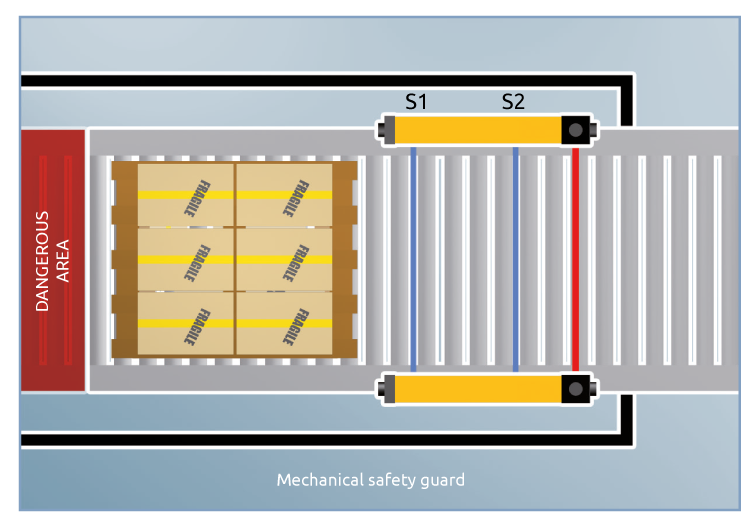Muting function
The Muting function is the provisional and automatic cut-out of the light curtain protective function in relation to the machine cycle. Muting can only occur in a safety condition. Two types of applications are envisaged:
- Enabling personnel access inside dangerous area during the non-dangerous part of machine cycle.
- Enabling access to material and preventing access to personnel.
Example: Positioning or removal of workpiece
Depending on the position of the tool, which is the most dangerous part, one of the two curtains (the one facing the tool
working area) is active whereas the other is in Muting mode to enable the operator to load/unload the workpiece. Muting mode of the light curtains is subsequently reversed when the tool
works on the opposite side of the machine.
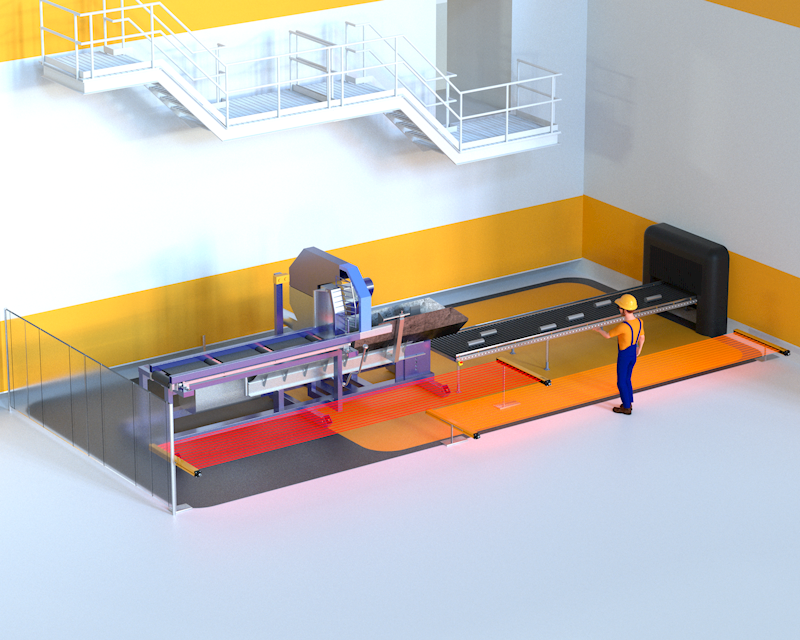
Example: Pallet exit from dangerous area
The safety light curtain incorporates Muting sensors able to discriminate between personnel and materials. Only the material is authorized to pass through the monitored area.
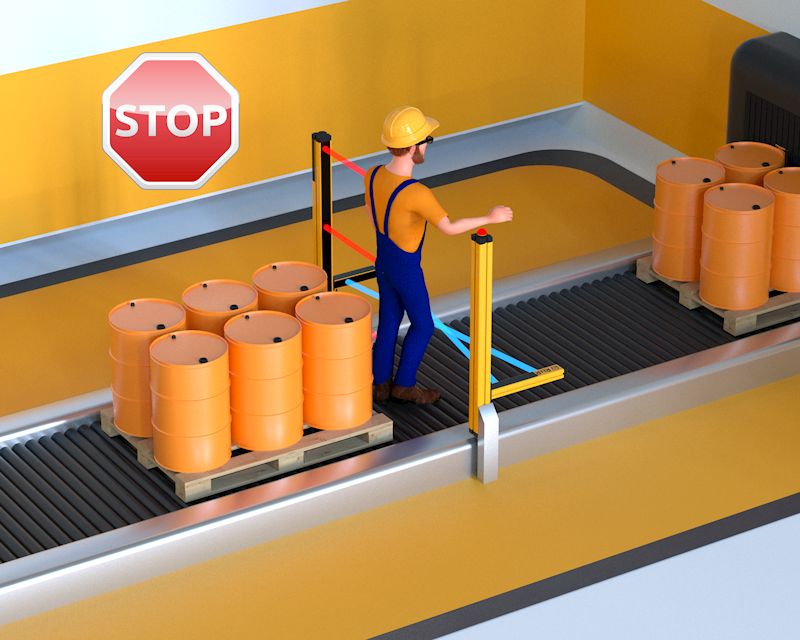
The essential requirements regarding the Muting Function are described by the followings Standards:
- IEC TS 62046 “Application of the protective equipment to detect the presence of persons”
- EN 415-10 “Safety of the Machinery – automatic palletizing systems”
- IEC 61496-1 “Electro-Sensitive Protective Equipment”
General Requirements:
- Muting is a temporary suspension of the safety–related function and it must be activated and de-activated automatically.
- The safety integrity level of the circuit implementing the Muting function shall be equal to that of the safety function temporarily suspended, so that the protection performance of the entire system is not adversely affected.
- Muting should be activated and de-activated only by means of two or more separate and indipendent hardwired signals triggered by a correct time or space sequence. Such that a signal fault cannot considered a muting condition.
- It shall not be possible to trigger Muting while the ESPE outputs are in the off state.
- It shall not be possible to initiate Muting by turning the device off and then on again.
- Muting shall be only activated in an appropriate point of the machine cycle, i.e. only when there is no risk for the operator.
- Muting sensors shall be mechanically protected to prevent mismatch in case of impact.
MUTING: palletizers and materials handling systems
Requirements for the monitoring of the openings:
- Monitor the load, not the pallet, otherwise the operator might go into the hazardous zone being dragged by the pallet.
- Muting time must be restricted to the actual time taken by the material to pass through the opening.
- Muting must be time-restricted.
- Sensor mismatch with effect similar to their actuation shall not allow a condition of permanent Muting.
- The configuration and positioning of the Muting sensors shall ensure reliable differentiation between personnel and material.
- The layout of the opening, the positioning of the Muting sensors and the additional side protections shall prevent personnel access to the dangerous area for all the time the Muting function is activated and throughout the time the pallet crosses the opening.
Therefore it is necessary to realise a safety system able to distinguish between:
| authorized materials | to go through the light curtain |
| non authorized people |
The Muting function can be present on both type 2 and type 4 safety light curtains.
Common solutions for Muting sensor positioning
The point of intersection of the two beams shall lie in the segregated dangerous area beyond the light curtain.
A fail safe timer shall be provided to restrict Muting to the time needed for the material to cross the opening.
The Muting function shall be activated only if the Muting sensors are contemporaneously intercepted: (t2(S2) – t1(S1) = 4 seconds max.).
The two beams shall be continuously interrupted by the pallet throughout the transit through the sensors.
A matt cylindrical object D=500 mm (simulating the size of a human body) shall not trigger the Muting function.
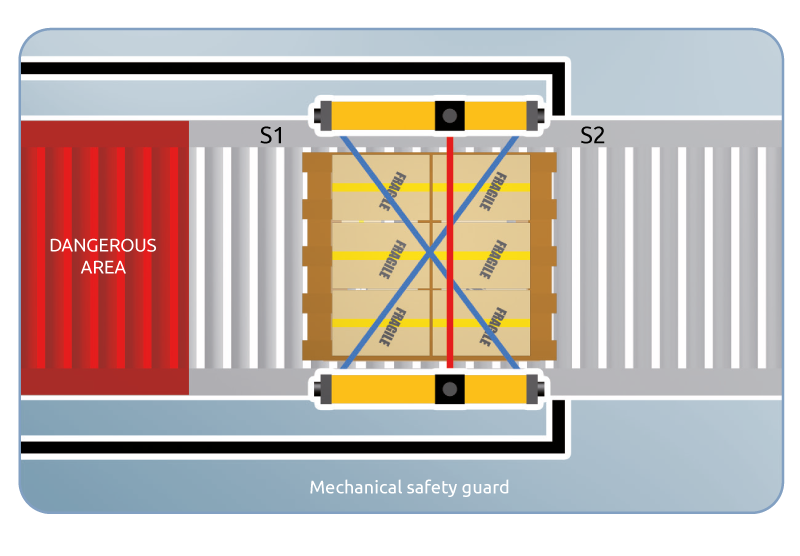
Muting sensor beam intersection shall be positioned the higher up or equal than level of the lower light curtain beam to avoid possible tampering or accidental triggering of Muting.
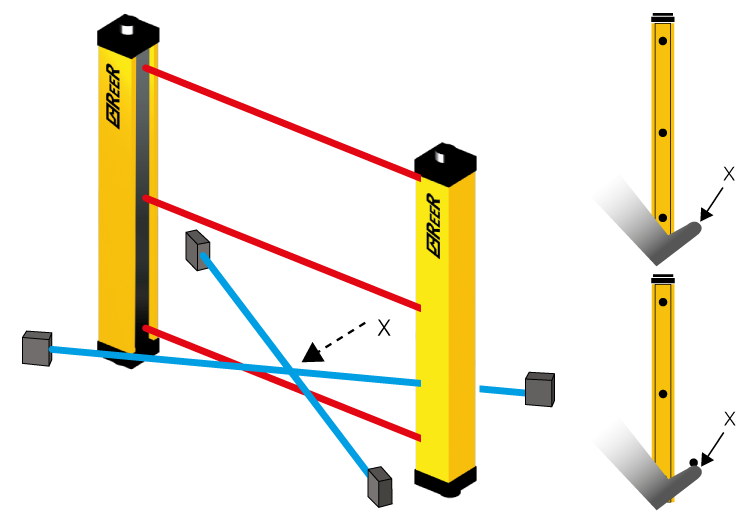
The 4 Muting sensors shall be all actuated together for a brief moment (sequential actuation and de-activation of the 4 sensors).
The distance between sensors and the sensing field of the light curtain shall be:
- d1 and d3 < 200 mm
to prevent undetected personnel access by preceding or following immediately after the pallet during Muting - d2 > 250 mm
to prevent personnel limb, garment, etc. from enabling Muting by triggering two sensors simultaneously.
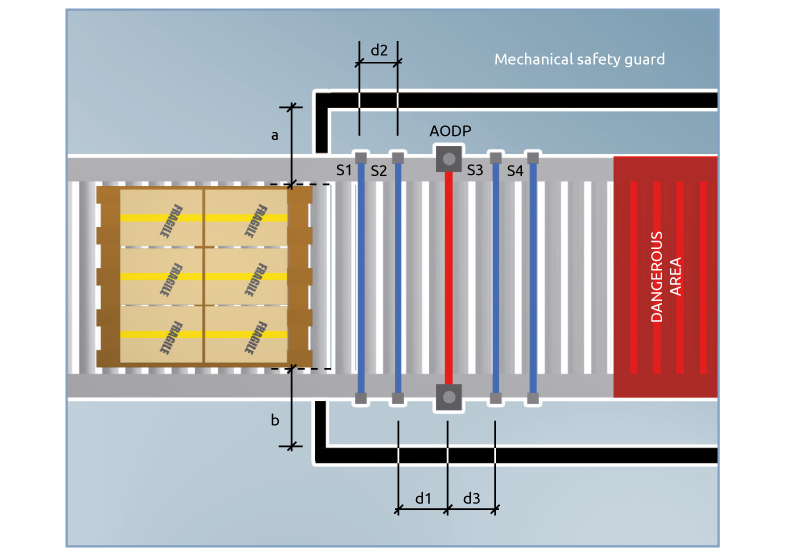
Muting sensors shall be positioned beyond the light curtain in the dangerous area.
Muting shall be disabled as soon as the light curtain is cleared and not later than 4 seconds max. from the instant the first of the two Muting sensor is cleared. The timer monitoring the 4 seconds shall be a safety-related item.
